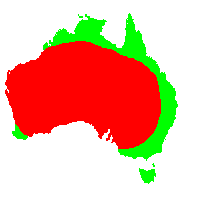General Description:
Senna is a widespread genus of about 350 species. About 46 occur in Australia of which about 33 are endemic. Senna and related genera such as Cassia, Labichea and Petalostylis may still be seen classified within the separate family Caesalpiniaceae but it is now more common for these plants to be classified as a sub-family within the widespread family Fabaceae.
Senna artemisioides is a woody shrub to 3 metres tall with a silvery appearance created by short white hairs on the branchlets and leaves. The leaves are pinnate with 4-8 pairs of leaflets. There are nine subspecies currently recognised. The form most commonly seen in gardens (subsp. artemisioides) is usually smaller – about 1.5 metres tall – and was previously known as Cassia artemisioides). The pinnate leaves of this form are about 2-4cm long and are narrowly cylindrical, grey green or silvery, 1-4 cm x 0.2-0.3 cm.
Bright yellow flowers about 1.5cm diameter are borne in small clusters in the leaf axils. These are followed by straight, brown pods 4-8 cm x 1 cm.
This species has been in cultivation for many years and is grown successfully in a wide range of climates. It is particularly suited to most drier areas as long as it is given full sun and good drainage.
Propagation is usually carried out from seed which germinates readily after treatment with boiling water. Cuttings of hardened, current seasons growth should also be successful.

Senna artemisioides subsp. artemisioides
Photo: Keith Townsend

Senna artemisioides subsp. oligiphylla
Photo: Brian Walters

Senna artemisioides subsp. sturtii
Photo: Brian Walters
Other Native Plant Profiles
 Australian Native Plants Society (Australia)
Australian Native Plants Society (Australia)